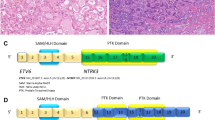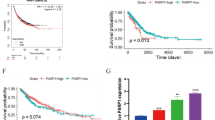Abstract
Objectives
Secondary lymph node metastasis (SLNM) indicates a poor prognosis, and limiting it can improve the survival rate in early-stage tongue squamous cell carcinoma (TSCC). Many factors have been identified as predictors of SLNM; however, there is no unified view. Ras-related C3 botulinum toxin substrate 1 (Rac1) was found to be a promoter of the epithelial–mesenchymal transition (EMT) and is also attracting attention as a new therapeutic target. This study aims to investigate the role of Rac1 in metastasis and its relationship with pathological findings in early-stage TSCC.
Materials and methods
Rac1 expression levels of 69 cases of stage I/II TSCC specimens and their association with clinicopathological characteristics were evaluated by immunohistochemical staining. The role of Rac1 in oral squamous cell carcinoma (OSCC) was examined after Rac1 in OSCC cell lines was silenced in vitro.
Results
High Rac1 expression was significantly associated with the depth of invasion (DOI), tumor budding (TB), vascular invasion, and SLNM (p < 0.05). Univariate analyses revealed that Rac1 expression, DOI, and TB were factors significantly associated with SLNM (p < 0.05). Moreover, our multivariate analysis suggested that Rac1 expression was the only independent determinant of SLNM. An in vitro study revealed that Rac1 downregulation tended to decrease cell migration and proliferation.
Conclusion
Rac1 was suggested to be an important factor in the metastasis of OSCC, and it could be useful as a predictor of SLNM.





Similar content being viewed by others
Abbreviations
- DFS:
-
Disease-free survival
- DOI:
-
Depth of invasion
- EMT:
-
Epithelial-mesenchymal transition
- END:
-
Elective neck dissedtion
- HR:
-
Hazard retios
- NCCN:
-
National Comprehensive Cancer Network
- OSCC:
-
Oral squamous cell carcinoma
- PBS:
-
Phosphate-buffered saline
- ROC:
-
Receiver operating characteristics
- TSCC:
-
Tongue squamous cell carcinoma
References
Dhanuthai K, Rojanawatsirivej S, Thosaporn W et al (2018) Oral cancer: a multicenter study. Med Oral Patol Oral Cir Bucal 23:e23–e29
Krishna Rao SV, MGK. KRoberts-Thomson et al (2013) Epidemiology of oral cancer in Asia in the past decade- an update(2000–2012). Asian Pac J cancer 14:5567–77
Tota JE, Anderson WF, Coffey C et al (2017) Rising incidence of oral tongue cancer among white men and women in the United States, 1973–2012. Oral Oncol 67:146–52
Report of Head and Neck Cancer Registry of Japan Clinical Statistics of Registered Patients, (2018) http://www.jshnc.umin.ne.jp/pdf/HNCreport_2018.pdf. Accessed October 2022
Lim SC, Zhang S, Ishii G et al (2004) Predictive markers for late cervical metastasis in stage I and II invasive squamous cell carcinoma of the oral tongue. Clin Cancer Res 10:166–172
Goto M, Hasegawa Y, Terada A et al (2005) Prognostic significance of late cervical metastasis and distant failure in patients with stage I and II oral tongue cancers. Oral Oncol 41:62–69
D’Cruz AK, Vaish R, Kapre N et al (2015) Elective versus therapeutic neck dissection in node-negative oral cancer. N Engl J Med 373:521–529
Wushou A, Yibulayin F, Sheng L et al (2021) Elective neck dissection improves the survival of patients with T2N0M0 oral squamous cell carcinoma: a study of the SEER database. B.M.C. Cancer 21:1309
Kurokawa H, Yamashita Y, Takeda S et al (2002) Risk factors for late cervical lymph node metastases in patients with stage I or II. Head Neck 24:731–736
Hori Y, Kubota A, Yokose T (2017) Predictive significance of tumor depth and budding for late Lymoh node metastases in patients with clinical N0 early oral tongue carcinoma. Head Neck 11:477–486
Nguyen KA, Le KQ (2022) Predictive factors of occult cervical lymph node metastasis in tongue cancer. Oral Sci Int, 1–7
Liu S, Liu L, Ye W et al (2016) High vimentin expression associated with lymph node metastasis and predicated a poor prognosis in oral squamous cell carcinoma. Sci Rep 6:38834
Aiello NM, Kang Y (2019) Context-dependent EMT programs in cancer metastasis. J Exp Med 216:1016–1026
Zhou Y, Liao Q, Han Y et al (2016) Rac1 overexpression is correlated with epithelial mesenchymal transition and predicts poor prognosis in non-small cell lung cancer. J Cancer 7:2100–2109
Leng R, Liao G, Wang H et al (2015) Rac1 expression in epithelial ovarian cancer: effect on cell EMT and clinical outcome. Med Oncol 32:329
Rajamani R, Berrier A, Alahari SK (2011) Role of Rho GTPase and their regulators in cancer progression. Front Biosci 16:2561–2571
Bustelo XR, Sauzeau V, Berenjeno IM (2007) GTP-binding proteins of the Rho/Rac family: regulation, effectors and functions in vivo. BioEssays 29:356–370
Ehrlich JS, Hansen MD, Nelson WJ (2002) Spation-temporal regulation of Rac1 localization and lamellipodia dynamics during Epithlial cell-cell adhesion. Dev Cell 3:259–270
Bid HK, Roberts RD, Manchanda PK et al (2013) Rac1: an emerging therapeutic option for targeting cancer angiogenesis and metastasis. Mol Cancer Ther 12:1925–1934
Ridley AJ (2001) Rho GTPases and cell migration. J Cell Sci 114:2713–2722
Yang WH, Lan HY, Huang CH et al (2012) RAC1 activation mediates Twist1-induced cancer cell migration. Nat Cell Biol 14:366–374
Yang Q, Luo GY, Li Y et al (2013) Expression of Rac-1 related to tumor depth, lymph node metastasis and patient prognosis in esophageal squamous cell carcinoma. Med Oncol 30:689
Schnelzer A, Prechtel D, Knaus U et al (2000) Rac1 in human breast cancer: overexpression, mutation analysis, and characterization of a new isoform, Rac1b. Oncogene 19:3013–3020
Crnogorac-Jurcevic T, Efthimiou E, Capelli P et al (2001) Gene expression profiles of pancreatic cancer and stromal desmoplasia. Oncogene 20:7437–7446
Zhou K, Rao J, Zhou ZH et al (2018) Rac1-GTP promotes epithelial-mesenchymal transition and invasion of colorectal cancer by activation of STAT3. Lab Invest 98:989–998
Ji J, Feng X, Shi M et al (2015) Rac1 is correlated with aggressiveness and a potential therapeutic target for gastric cancer. Int J Oncol 46:1343–1353
Toyama Y, Kontani K, Katada T et al (2019) Conformational landscape alternations promote oncogenic activities of Ras-related C3 botulinum toxin substrate 1 as revealed by NMR. Sci Adv 5:eaav8945
Matsuoka Y, Al-Shareef H, Kogo M et al (2021) Effects of decreased Rac activity and malignant state on oral squamous cell carcinoma in vitro. PLoS ONE 16:e0212323
Liu SY, Yen CY, Yang SC et al (2004) Overexpression of Rac-1 small GTPase binding protein in oral squamous cell carcinoma. J Oral Maxillofac Surg 62:702–707
Lydiatt WM, Patel SG, O’Sullivan B, et al (2017) Head and neck cancers-major changes in the American Joint Committee on Cancer eighth edition cancer staging manual. C.A. Cancer J Clin, 67: 122–37
Yoon C, Cho SJ, Chang KK et al (2017) Role of Rac1 pathway in epithelial-to-mesenchymal transition and cancer stem-like cell phenotypes in gastric adenocarcinoma. Mol Cancer Res 15:1106–1116
Tobar N, Villar V, Santibanez JF (2010) ROS-NFkappaB mediates TGF-beta1-induced expression of urokinase-type plasminogen activator, matrix metalloproteinase-9 and cell invasion. Mol Cell Biochem 340:195–202
Zhu G, Wang Y, Huang B et al (2012) A Rac1/PAK1 cascade controls β-catenin activation in colon cancer cells. Oncogene 31:1001–1012
Jaffe AB, Hall A (2005) Rho GTPases: biochemistry and biology. Annu Rev Cell Dev Biol 21:247–269
Gastonguay A, Berg T, Hauser AD et al (2012) The role of Rac1 in the regulation of NF-κB activity, cell proliferation, and cell migration in non-small cell lung carcinoma. Cancer Biol Ther 13:647–656
Kaneto N, Yokoyama S, Hayakawa Y et al (2014) Rac1 inhibition as a therapeutic target for gefitinib-resistant non-small-cell lung cancer. Cancer Sci 105:788–794
Kogai T, Liu YY, Mody K et al (2012) Regulation of sodium iodide symporter gene expression by Rac1/p38β mitogen-activated protein kinase signaling pathway in MCF-7 breast cancer cells. J Biol Chem 287:3292–3300
Bauer NN, Chen YW, Samant RS et al (2007) Rac1 activity regulates proliferation of aggressive metastatic melanoma. Exp Cell Res 313:3832–3839
LoPiccolo J, Blumenthal GM, Bernstein WB et al (2008) Targeting the PI3K/Akt/mTOR pathway: effective combinations and clinical considerations. Drug Resist Upda 11:32–50
Serafino A (2012) New molecular biomarkers candidates for the development of multiparametric platforms for hepatocellular carcinoma diagnosis, prognosis and personalised therapy. http://cancerlink.ru/ennew-molecular-biomarkers-for-hepatocellular-carcinoma-diagnosis.html. Accessed October 2022
Le PN, McDermott JD, Jimeno A (2015) Targeting the Wnt pathway in human cancers: therapeutic targeting with a focus on OMP-54F28. Pharmacol Ther 146:1–11
Kamai T, Shirataki H, Nakanishi K et al (2010) Increased Rac1 activity and Pak1 overexpression are associated with lymphovascular invasion and lymph node metastasis of upper urinary tract cancer. B.M.C. Cancer 10:164
Du X, Wang S, Lu J et al (2012) Clinical value of Tiam1-Rac1 signaling in primary gallbladder carcinoma. Med Oncol 29:1873–1878
Ueno H, Murphy J, Jass JR et al (2002) Tumor ‘budding’ as an index to estimate the potential of aggressiveness in rectal cancer. Histopathology 40:127–132
Grigore AD, Jolly MK, Jia D et al (2016) Tumor budding: the name is EMT. Partial EMT J Clin Med 5:51
Head and Neck Cancers Version 1, (2022) National Comprehensive Cancer Network (NCCN)
Zenga J, Divi V, Stadler M et al (2019) Lymph node yield, depth of invasion, and survival in node-negative oral cavity cancer. Oral Oncol 98:125–131
Acknowledgements
The authors thank Kazunari Higa and Junichirou Inada for their support and technical assistance
Author information
Authors and Affiliations
Contributions
MY, TN: Study concepts, Study design, MY,TS: Data acquisition, MY, KH, HS: Quality control of data and algorithms, MY, SS: Data analysis and interpretation, MY, SO: Statistical analysis, MY, SS, SO: Manuscript preparation, MY, TS: Manuscript editing, MY, TN: Manuscript review.
Corresponding author
Ethics declarations
Conflict of interest
None declared.
Additional information
Publisher's Note
Springer Nature remains neutral with regard to jurisdictional claims in published maps and institutional affiliations.
About this article
Cite this article
Yamazaki, M., Sekikawa, S., Suzuki, T. et al. Rac1 activation in oral squamous cell carcinoma as a predictive factor associated with lymph node metastasis. Int J Clin Oncol 28, 1129–1138 (2023). https://doi.org/10.1007/s10147-023-02374-2
Received:
Accepted:
Published:
Issue Date:
DOI: https://doi.org/10.1007/s10147-023-02374-2




